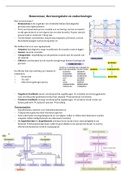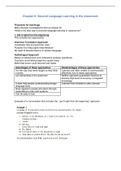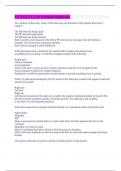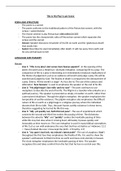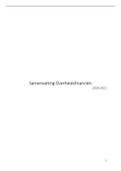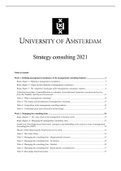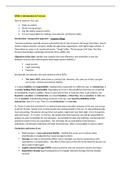Summary International Accounting
I. Introduction
Financial statements: primary objective: support decision making of different stakeholders
A. Ratio analysis
➔ Benchmarking necessary
▪ Cross-sectional
▪ Time series analysis
- Profitability ratios: reasonable profit level
- Liquidity: short term ability to pay debt
- Leverage: appropriate long-term debt level
Comparability financial ratios:
- Consolidated or individual company accounts
- Which accounting standard was used
o IFRS (set by IASB)
o US GAAP (set by FASB)
o Local GAAP
- Level of judgment given certain accounting standard
Notes to FS important for analysis! Be cautious in comparing financial ratios between firms
B. Accounting standards
IFRS US GAAP
- Principle based accounting standards: broad principles - Rule based accounting standards: significant guidance
to account for transactions across industries with for transactions, industries, exceptions and specific
limited specific guidance and stated exceptions to the recognition and measurement guidance
general guidance - Developed for a specific jurisdiction
- Not developed for a specific jurisdiction
- More professional judgment needed with possible
negative effects on comparability
C. CH 1 – The regulatory framework
Need for regulation: companies are owned by shareholders,
that have no day-to-day involvement with the company.
Shareholders, creditors and othersely on financial reports for
info to help them make important decisions.
➔ Regulators try to ensure that financial statements provide
a faithful representation
1. Sources of regulation
- Legislation : varies from country to country
- Accounting standards: national and international
- Stock exchange regulation: eg requirement to publish quarterly figures
2. GAAP – IASB – IFRS Foundation – Standard setting process
From slide 30 – Course 1
Purpose of accounting standards: reduce variation in accounting practice and introduce degree of uniformity into financial
reporting. Make it more likely that FS will provide a faithful representation of entity’s financial performance and position.
First time adoption of IFRS:
, - Date of transition: date at start of earliest period for which comparatives are provided in the first IFRS financial
statements : opening IFRS statement of financial position
D. CH2 : conceptual framework financial reporting
Definition: a ‘constitution’, a coherent system of interrelated objectives and fundamentals, that can lead to consistent standards
and that prescribes nature, function and limits of financial accounting and standards
➔ Assist in development of IFRS / IAS, provide basis for reducing alternatives, assist preparers of FS in applying
international standards
1. Objective
Objective general purpose financial reporting:
provide info about entity’s :
- Financial position
- Financial performance (accruals basis)
- Cash flows
- Changes in financial position not caused
by financial performance
2. Characteristics financial statements
Underlying assumption in preparation of financial statements:
- going concern basis: assumed that entity will continue in operation for foreseeable future and has neither the
intention, nor the need to close down or materially reduce the scale of its operations
- Accrual basis
Qualitative characteristics financial information:
- Fundamental characteristics:
o Relevance : predictive of confirmatory
value
o Faithful representation : complete,
neutral, error-free
- Enhancing characteristics:
o Comparability : consistent accounting
treatments
o Timeliness : in time to influence
decisions
o Verifiability : direct or indirect
o Understandability: clear and concise presentation
3. Preparation of financial statements
Elements of financial position:
- Asset: "a resource controlled by the entity as a result of past events and from which future economic benefits are
expected to flow to the entity”
- Liability : "a present obligation of the entity arising from past events, the settlement of which is expected to result in an
outflow from the entity of resources embodying economic benefits”
- Equity: "the residual interest in the assets of the entity after deducting all its liabilities"
, - Income : Increases in economic benefits during an accounting period ‒That result in an increase in equity ‒Other than
those that arise from contributions from equity holders
o Revenue: During the course of ordinary activities
o Gains: not “”
- Expense: Decreases in economic benefits during an accounting period ‒Other than those relating to distributions to
equity holders
o Expenses: during the course of ordinary activities
o Losses: not “””
Recognition: inclusion of an element in the income statement or statement of financial position. Item should be recognised if:
- Probable that future economic benefits will flow to or from the entity
- Item has a cost or value that can be measured reliably
Measurement bases: from slide 58
- Historical cost : amount paid to acquire them / received to settle liability: mostly used : historical cost accounting
- Current cost : amount that would have to be paid / received now for equivalent asset : current cost accounting
- Realisable value : fair value if it was sold : current purchasing power
- Present value: PV of the net CF that the entity expects to derive from it
E. CH 3 : Presentation of financial statements
Objective financial statements: Provide information about the financial position and financial performance and cash flows of an
entity or a group of entities ‒That is useful for making economic decisions ‒To a wide range of users
Frequency of reporting: at least annually: if longer / shorter period : give reason and fact that amounts not directly comparable
with those of last year
Statement of financial position: balance sheet: current vs non-current distinction:
An asset/ liability is a current asset/liability if it is any of the following criteria:
- It is expected to be realised/ settled within the entity’s normal operating cycle
- Held for the purpose of being traded
- Expected to be realised/settled withing 12 months of the reporting period
- It is cash / cash equivalent / cannot defer payment for at least 12 months after reporting period
Statement of comprehensive income:
- Single statement of comprehensive income
- Two separate statements, comprising:
o Statement with P&L
o Other comprehensive income
F. CH4: Accounting policies, accounting estimates and errors – IAS 8
Accounting policy: the specific principles, bases, conventions, rules and practices applied by an entity in preparing and
presenting financial statements".
May only change if:
- Change required by an international standard
- Change results in more reliable and more relevant information
Accounting for a change in policy:
- Traditional provisions: if it results from application international standards
- Retrospective application: other cases
Disclosures changes: slide 87 course 1
Accounting estimates: many items cannot be measured with precision but can be estimated. Use of reasonable estimates is
essential part of preparation of FS and does not undermine reliability.
Changes: apply prospectively
I. Introduction
Financial statements: primary objective: support decision making of different stakeholders
A. Ratio analysis
➔ Benchmarking necessary
▪ Cross-sectional
▪ Time series analysis
- Profitability ratios: reasonable profit level
- Liquidity: short term ability to pay debt
- Leverage: appropriate long-term debt level
Comparability financial ratios:
- Consolidated or individual company accounts
- Which accounting standard was used
o IFRS (set by IASB)
o US GAAP (set by FASB)
o Local GAAP
- Level of judgment given certain accounting standard
Notes to FS important for analysis! Be cautious in comparing financial ratios between firms
B. Accounting standards
IFRS US GAAP
- Principle based accounting standards: broad principles - Rule based accounting standards: significant guidance
to account for transactions across industries with for transactions, industries, exceptions and specific
limited specific guidance and stated exceptions to the recognition and measurement guidance
general guidance - Developed for a specific jurisdiction
- Not developed for a specific jurisdiction
- More professional judgment needed with possible
negative effects on comparability
C. CH 1 – The regulatory framework
Need for regulation: companies are owned by shareholders,
that have no day-to-day involvement with the company.
Shareholders, creditors and othersely on financial reports for
info to help them make important decisions.
➔ Regulators try to ensure that financial statements provide
a faithful representation
1. Sources of regulation
- Legislation : varies from country to country
- Accounting standards: national and international
- Stock exchange regulation: eg requirement to publish quarterly figures
2. GAAP – IASB – IFRS Foundation – Standard setting process
From slide 30 – Course 1
Purpose of accounting standards: reduce variation in accounting practice and introduce degree of uniformity into financial
reporting. Make it more likely that FS will provide a faithful representation of entity’s financial performance and position.
First time adoption of IFRS:
, - Date of transition: date at start of earliest period for which comparatives are provided in the first IFRS financial
statements : opening IFRS statement of financial position
D. CH2 : conceptual framework financial reporting
Definition: a ‘constitution’, a coherent system of interrelated objectives and fundamentals, that can lead to consistent standards
and that prescribes nature, function and limits of financial accounting and standards
➔ Assist in development of IFRS / IAS, provide basis for reducing alternatives, assist preparers of FS in applying
international standards
1. Objective
Objective general purpose financial reporting:
provide info about entity’s :
- Financial position
- Financial performance (accruals basis)
- Cash flows
- Changes in financial position not caused
by financial performance
2. Characteristics financial statements
Underlying assumption in preparation of financial statements:
- going concern basis: assumed that entity will continue in operation for foreseeable future and has neither the
intention, nor the need to close down or materially reduce the scale of its operations
- Accrual basis
Qualitative characteristics financial information:
- Fundamental characteristics:
o Relevance : predictive of confirmatory
value
o Faithful representation : complete,
neutral, error-free
- Enhancing characteristics:
o Comparability : consistent accounting
treatments
o Timeliness : in time to influence
decisions
o Verifiability : direct or indirect
o Understandability: clear and concise presentation
3. Preparation of financial statements
Elements of financial position:
- Asset: "a resource controlled by the entity as a result of past events and from which future economic benefits are
expected to flow to the entity”
- Liability : "a present obligation of the entity arising from past events, the settlement of which is expected to result in an
outflow from the entity of resources embodying economic benefits”
- Equity: "the residual interest in the assets of the entity after deducting all its liabilities"
, - Income : Increases in economic benefits during an accounting period ‒That result in an increase in equity ‒Other than
those that arise from contributions from equity holders
o Revenue: During the course of ordinary activities
o Gains: not “”
- Expense: Decreases in economic benefits during an accounting period ‒Other than those relating to distributions to
equity holders
o Expenses: during the course of ordinary activities
o Losses: not “””
Recognition: inclusion of an element in the income statement or statement of financial position. Item should be recognised if:
- Probable that future economic benefits will flow to or from the entity
- Item has a cost or value that can be measured reliably
Measurement bases: from slide 58
- Historical cost : amount paid to acquire them / received to settle liability: mostly used : historical cost accounting
- Current cost : amount that would have to be paid / received now for equivalent asset : current cost accounting
- Realisable value : fair value if it was sold : current purchasing power
- Present value: PV of the net CF that the entity expects to derive from it
E. CH 3 : Presentation of financial statements
Objective financial statements: Provide information about the financial position and financial performance and cash flows of an
entity or a group of entities ‒That is useful for making economic decisions ‒To a wide range of users
Frequency of reporting: at least annually: if longer / shorter period : give reason and fact that amounts not directly comparable
with those of last year
Statement of financial position: balance sheet: current vs non-current distinction:
An asset/ liability is a current asset/liability if it is any of the following criteria:
- It is expected to be realised/ settled within the entity’s normal operating cycle
- Held for the purpose of being traded
- Expected to be realised/settled withing 12 months of the reporting period
- It is cash / cash equivalent / cannot defer payment for at least 12 months after reporting period
Statement of comprehensive income:
- Single statement of comprehensive income
- Two separate statements, comprising:
o Statement with P&L
o Other comprehensive income
F. CH4: Accounting policies, accounting estimates and errors – IAS 8
Accounting policy: the specific principles, bases, conventions, rules and practices applied by an entity in preparing and
presenting financial statements".
May only change if:
- Change required by an international standard
- Change results in more reliable and more relevant information
Accounting for a change in policy:
- Traditional provisions: if it results from application international standards
- Retrospective application: other cases
Disclosures changes: slide 87 course 1
Accounting estimates: many items cannot be measured with precision but can be estimated. Use of reasonable estimates is
essential part of preparation of FS and does not undermine reliability.
Changes: apply prospectively


